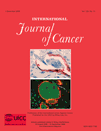Characterization of humoral immune responses against p16, p53, HPV16 E6 and HPV16 E7 in patients with HPV-associated cancers
Abstract
The cellular tumor suppressor p16 is strongly overexpressed in cervical cancers and precancers. We have previously demonstrated that infiltrating T lymphocytes reactive against p16 can be found in cervical cancer patients. Here, we analyzed whether p16 induces humoral immune responses. Sera of patients with cervical cancer, oropharyngeal cancer, colorectal cancer and autoimmune disease were included. A total of 919 sera were analyzed, including 486 matched sera from a cervical cancer case control study. p16 antibodies were analyzed in Western blot and a newly developed peptide ELISA covering the complete p16 protein. In addition, a Luminex-based multiplex assay was used for simultaneous detection of antibodies directed against p16, p53, HPV16 E6 and HPV16 E7. In all entities, only low p16 antibody reactivity was observed. Epitope mapping revealed 2 predominant epitope regions of the p16 protein. No significant difference in p16 antibody frequency (OR = 0.9; 95% CI = 0.6–1.3) and p53 antibody frequency (OR = 0.6; 95% CI = 0.3–1.2) was found between patients and healthy controls in the cervical cancer case control study. Antibodies against the HPV16 oncoproteins E6 and E7 were detected more frequently in cervical cancer patients when compared with healthy controls (E6 OR = 27.8; 95% CI = 11.1–69.7, E7 OR = 5.7; 95% CI = 2.9–11.1). In conclusion, despite the strong expression of p16 and the observed induction of cellular immune responses, antibody reactivity against p16 was observed only at very low levels independent of the disease background. © 2008 Wiley-Liss, Inc.




